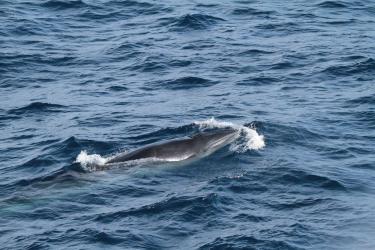On April 11, 2024, NOAA Fisheries scientists observed two endangered Rice’s whales in the western Gulf of Mexico. There are likely fewer than 100 Rice’s whales in the Gulf of Mexico, the only area where the species is known to occur.
The whales were observed 55 nautical miles off the coast of Corpus Christi, Texas. The three characteristic ridges on their rostra (in front of their blowhole) were clearly visible and allowed the team to confirm they were Rice’s whales. The whales were observed at the ocean surface, and were diving within a small area. They were in an area where the water was approximately 224 meters deep.
In addition to a confirmed sighting in 2017, this event reinforces findings from acoustic monitoring that Rice's whales occur in waters near Texas. In fact, the whales were observed 4.8 nautical miles from one of these passive acoustic monitoring instruments.
These sightings occurred within the proposed Rice’s whale critical habitat, which encompasses waters 100–400 meters deep throughout the U.S. Gulf of Mexico.
Laura Dias and Jesse Wicker, NOAA Fisheries affiliates through the University of Miami Cooperative Institute for Marine and Atmospheric Studies, were co-leads on the mission.
Mid-flight, Laura Dias asked the NOAA Corps pilots to turn the aircraft towards where she saw some movement on the water.
“Conditions were improving but there were still some waves on the surface. That movement could have been anything, but when we got there, I felt a wave of excitement and relief—we found our first whale! That was the beginning of an intense effort to photograph this whale and further document the presence of Rice’s whales in the western Gulf of Mexico.”
A Better Vantage Point
These sightings happened during an aerial survey to document the abundance and distribution of marine mammals and sea turtle species, including the endangered Rice’s whale, in the western Gulf. In addition to advancing our understanding of these species in the Gulf, the survey data will support marine spatial planning efforts related to the New Blue Economy.
Previously, aerial surveys in this region surveyed from shore out to 200 meters water depth. This time, the study area targeted a different depth range, from 100 to 500 meters. This includes areas over which passive acoustic monitoring devices have previously recorded Rice’s whale sounds.
Aerial surveys complement traditional ship-based surveys by allowing the team to:
- Cover a broader area faster
- Cover areas of interest multiple times
- Photograph animals directly from above to assess body condition
- View the whales’ characteristic three rostral ridges
- Collect overhead imagery of the entire body of the animal
- Observe these endangered animals using non-invasive methods
NOAA's Aircraft Operations Center supported this survey with their De Havilland DHC-6-300 Twin Otter, N46RF.
What This Means for Rice’s Whales
These sightings will help us target additional surveys that could be used to improve the Rice’s whale abundance estimate.
“These sightings, combined with the nearby 2017 vessel-based sighting and a year of acoustic recordings showing Rice's whale calls present in this area on 25 percent of days, highlight the strength of using complementary visual and acoustic survey methods for improving our understanding of how important this area is to this very rare endangered species,” said Melissa Soldevilla, the Southeast Fisheries Science Center’s passive acoustic monitoring program lead.
Threats to Rice’s whales from human activities include:
- Vessel strikes
- Noise from vessels and energy exploration
- Oil spills and other pollutants, including lingering effects of the Deepwater Horizon oil spill
- Ingestion of and entanglement in marine debris
- Climate change and its effect on prey
- Entanglement in fishing gear
The Rice’s whale, which was determined to be a unique species in 2021, is now a part of NOAA Fisheries’ Species in the Spotlight initiative. This campaign brings additional awareness to endangered species. NOAA Fisheries continues to study and monitor Rice’s whales to help conserve and recover the species.
Check out our frequently asked questions on Rice’s whales
Help Keep Whales Safe
Boaters, anglers, and others should report all suspected sightings of Rice’s whales by calling (877) WHALE-HELP (877-942-5343). This information is valuable for helping us learn more about this endangered species. You can also use this same number to report any marine mammal that is in distress, injured or dead.
Harassing, harming, pursuing, wounding, killing, capturing, or collecting protected marine mammals is prohibited by the Endangered Species Act and Marine Mammal Protection Act. Observe marine animals from a safe and respectful distance—at least 100 yards (the length of a football field)—and never approach or touch them.



